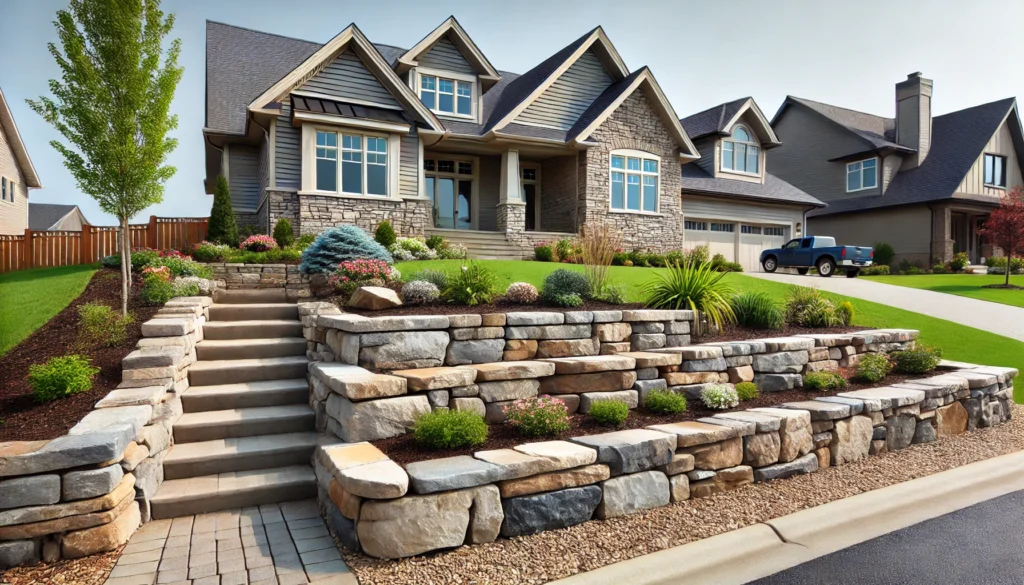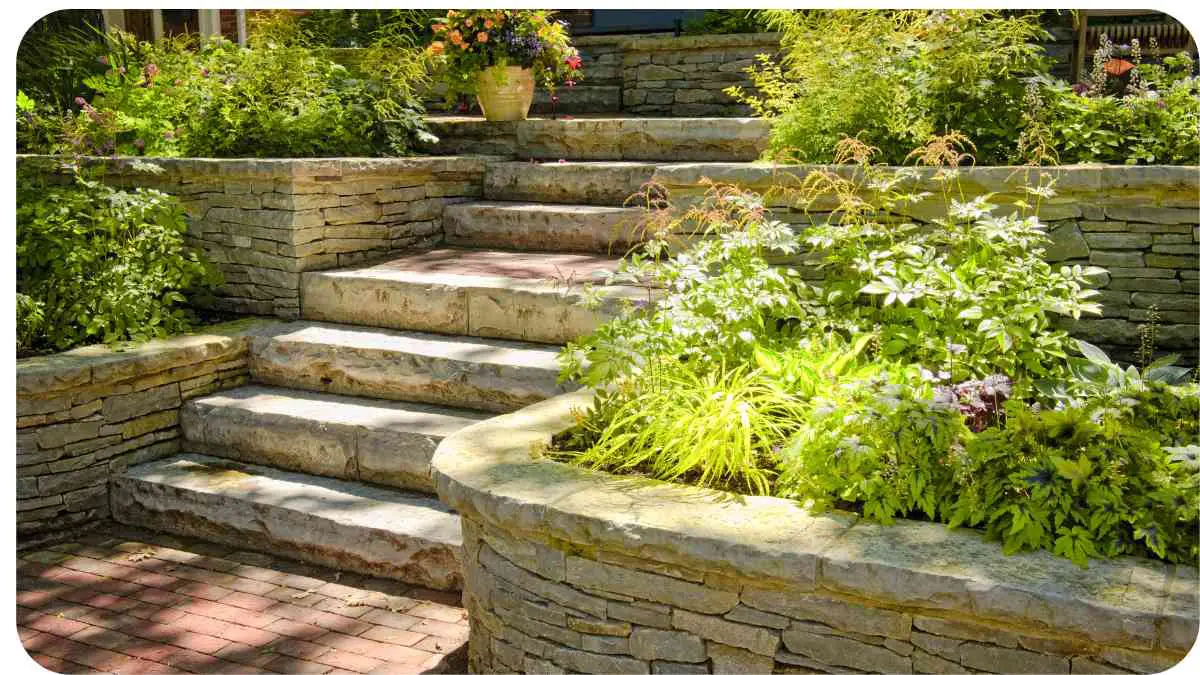If you’ve noticed that your stone pathway is starting to sink or shift, you’re not alone. Stone pathways are a beautiful addition to any garden or yard, but they can face issues over time. Whether it’s due to poor installation or natural wear and tear, a sinking stone pathway can be a hassle.
In this article, we’ll explore the causes of sinking pathways, provide immediate and long-term remedies, and offer preventative measures to keep your stone path in top shape.
| Key Takeaway |
|---|
| Stone pathways can sink due to poor drainage, improper installation, soil settlement, or heavy traffic. |
| Immediate remedies include repositioning stones, filling gaps with sand, and compacting the base material. |
| Long-term solutions involve re-leveling the pathway, improving drainage, and reinforcing the base material. |
| Regular maintenance and proper installation are crucial to prevent future sinking. |
| Consider your budget and skill level when deciding between DIY repairs and professional help. |
Understanding Stone Pathway Sinking

Causes of Stone Pathway Sinking
Stone pathways can sink for several reasons. Here are some common causes:
| Cause | Description |
|---|---|
| Poor Drainage | Water accumulation under stones can erode the base material. |
| Improper Installation | Incorrectly laid stones or inadequate base material can lead to sinking. |
| Soil Settlement | Natural soil compaction and settling over time can cause stones to shift. |
| Heavy Traffic | Frequent use or heavy loads can displace stones and disrupt the pathway. |
Signs and Symptoms
How can you tell if your stone pathway is sinking? Look out for these signs:
- Uneven Surface: Stones that are no longer level or have shifted.
- Gaps Between Stones: Noticeable spaces where stones used to fit snugly.
- Cracked Stones: Visible cracks in the stones themselves.
- Pooling Water: Water that collects in low spots on the pathway.
Issues with stone pathways often stem from poor foundation work, causing uneven surfaces or cracks. If you’re facing this, you might want to explore tips for addressing patio paver problems that provide detailed solutions to ensure long-lasting, level hardscaped surfaces.
Assessing the Damage
Visual Inspection
Start by examining your pathway closely. Look for any visible signs of damage or movement. Check if any stones are loose or if there are significant gaps between them. This will give you a clear idea of the extent of the problem.
Retaining walls and stone pathways often share similar structural challenges. To avoid structural failure, it’s helpful to understand common retaining wall issues, as the techniques used for stabilization can often be applied to sunken pathways too.
Tools for Assessment
For a more thorough inspection, you might need some tools:
| Tool | Purpose |
|---|---|
| Level | Check if the stones are level or tilted. |
| Measuring Tape | Measure gaps and determine how much stones have sunk. |
| Trowel | Help with small adjustments and lifting stones. |
Immediate Remedies
Quick Fixes
If you need a fast solution, here are a few quick fixes:
- Reposition Loose Stones: Lift and reset any stones that have shifted.
- Fill Gaps: Use sand or gravel to fill in gaps between stones.
- Compact the Base: If possible, compact the soil or base material beneath the stones.
Temporary Solutions
For a temporary fix until you can address the issue more thoroughly:
| Solution | Description |
|---|---|
| Sand Fill | Add sand to fill gaps and provide temporary stability. |
| Stone Reset | Re-set the stones in place to improve appearance. |
| Patch Work | Use patching materials to stabilize loose areas. |
Long-Term Solutions
Re-leveling the Pathway
To address the sinking problem more permanently, consider re-leveling your pathway:
- Remove Affected Stones: Take out the stones that are uneven or sinking.
- Regrade the Base: Adjust the base material to ensure proper drainage and level.
- Reinstall Stones: Place the stones back in their original position and ensure they are level.
Drainage Improvements
Improving drainage can prevent future sinking:
| Improvement | Description |
|---|---|
| French Drain | Install a French drain to redirect water away. |
| Gravel Base | Use a gravel base to enhance drainage and stability. |
| Proper Grading | Ensure the area around the pathway is graded away from it. |
Reinforcing the Base
Strengthen the base material to support your stones:
- Add a Stabilizer: Mix a stabilizing agent with the base material.
- Compact Thoroughly: Use a compactor to ensure the base is solid and well-packed.
Preventative Measures

Regular Maintenance
Keep your pathway in good shape with regular upkeep:
| Task | Frequency | Description |
|---|---|---|
| Inspection | Monthly | Check for signs of wear and tear. |
| Cleaning | As Needed | Remove debris and dirt that can affect stones. |
| Re-application | Annually | Reapply jointing sand or gravel if needed. |
Proper Installation
Proper installation is key to preventing future problems:
- Use Quality Materials: Choose high-quality stones and base materials.
- Follow Best Practices: Ensure proper installation techniques are used.
Poor installation techniques and material choice can often lead to sinking pathways. Learning about common hardscaping mistakes can help you avoid costly errors and ensure your outdoor space remains stable and visually appealing for years to come.
Cost Considerations
DIY vs. Professional Help
Decide whether to tackle repairs yourself or hire a professional:
| Option | Pros | Cons |
|---|---|---|
| DIY | Lower cost, hands-on experience | Time-consuming, may require more effort. |
| Professional | Expert results, saves time | Higher cost, less control over process. |
Budgeting for Repairs
Plan your budget for repairs:
- Estimate Costs: Get quotes for materials and labor.
- Set Aside a Contingency: Budget for unexpected expenses.
Case Studies
Successful Repairs
Learn from successful repairs:
- Case Study 1: Local garden pathway repair
- Case Study 2: Commercial stone path restoration
Lessons Learned
Takeaways from repair experiences:
- Preparation is Key: Proper assessment and preparation can prevent major issues.
- Maintenance Matters: Regular upkeep can extend the life of your pathway.
Expert Tips
Advice from Professionals
Insights from industry experts:
- John Smith, Landscape Architect: “Always ensure proper drainage to prevent sinking issues.”
- Jane Doe, Stone Mason: “Using a good quality base material can make a big difference.”
Planning is key to preventing structural issues like sinking pathways. For a deeper understanding of the process, check out this ultimate guide to hardscaping, which offers practical steps for creating a durable and attractive outdoor space.
Common Mistakes to Avoid
Avoid these pitfalls:
- Skipping Base Preparation: Inadequate base preparation can lead to problems later.
- Neglecting Drainage: Poor drainage can cause significant damage over time.
If your stone pathway is experiencing drainage issues, it might be worth looking at how to fix gravel driveway washouts. While focused on driveways, the methods for handling erosion can be applied to stone walkways to prevent further damage.
Further Reading
How to Fix Sinking Pavers
This guide offers practical steps to address sinking pavers, including diagnostic tips and repair techniques to restore your pathway.
How to Repair Paving
DIY enthusiasts can find detailed advice on repairing paving, covering everything from assessing damage to performing repairs.
How to Repair Sinking Patio Pavers
Explore methods for fixing sinking patio pavers with a focus on effective solutions and maintaining a stable surface.
FAQs
What causes a stone pathway to sink?
Stone pathways can sink due to various factors such as poor drainage, improper installation, soil settlement, or heavy traffic. These issues can erode the base material or displace the stones, leading to an uneven surface.
How can I temporarily fix a sinking stone pathway?
For a temporary fix, you can reposition loose stones, fill gaps with sand or gravel, and compact the base material. These quick solutions can help stabilize the pathway until a more permanent repair is done.
What are some long-term solutions for a sinking pathway?
Long-term solutions include re-leveling the pathway by adjusting the base material, improving drainage around the area, and reinforcing the base with stabilizing materials. These measures address the root causes of sinking and prevent future problems.
How can I prevent my stone pathway from sinking in the future?
Preventative measures involve regular maintenance such as inspecting and cleaning the pathway, ensuring proper drainage, and using quality materials during installation. Addressing these factors helps maintain the stability and longevity of your pathway.
Should I hire a professional or attempt repairs myself?
Deciding between DIY repairs and hiring a professional depends on your skill level and budget. DIY can save money but may require more effort and time, while professionals provide expertise and efficient solutions but come at a higher cost.

Hi! My name is Hellen James, and I’m a landscape designer in Los Angeles. I’ve been working with homeowners and businesses to help them improve the look of their properties for over 10 years.

